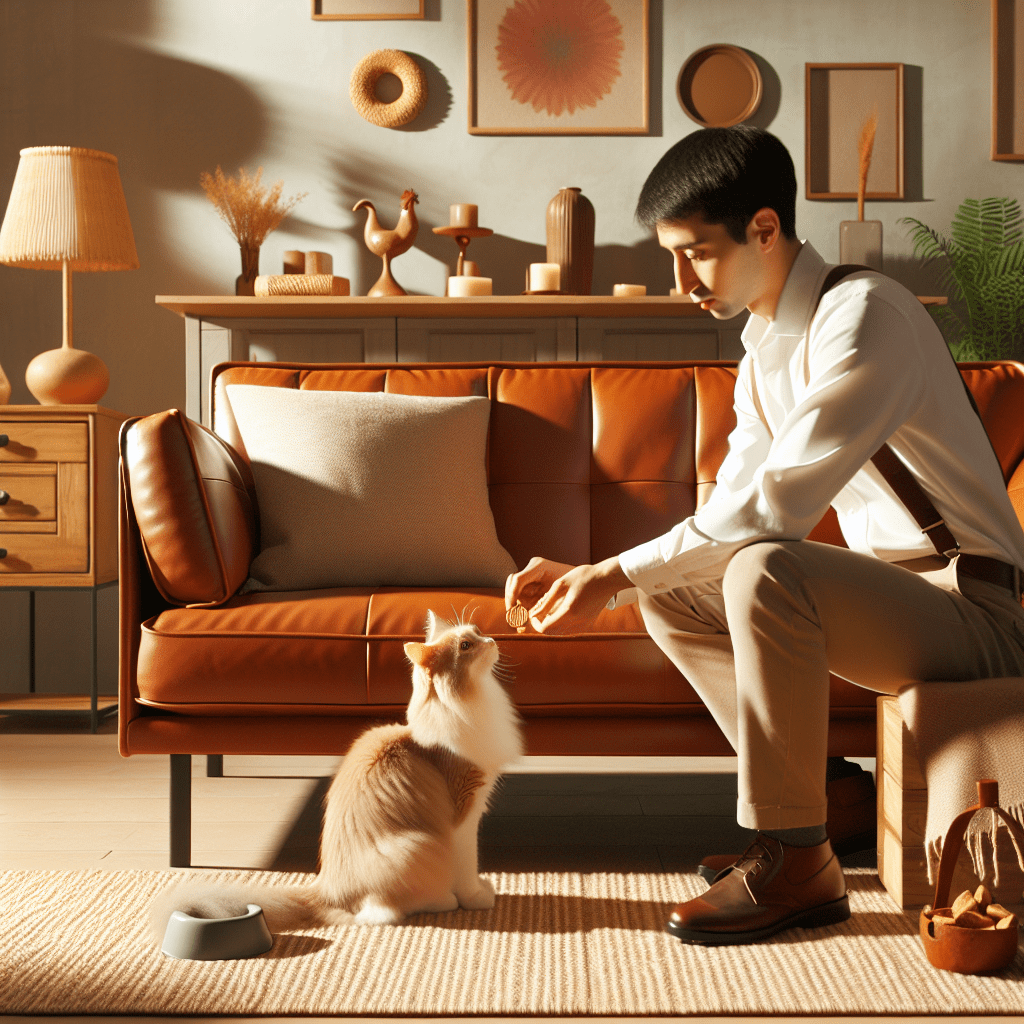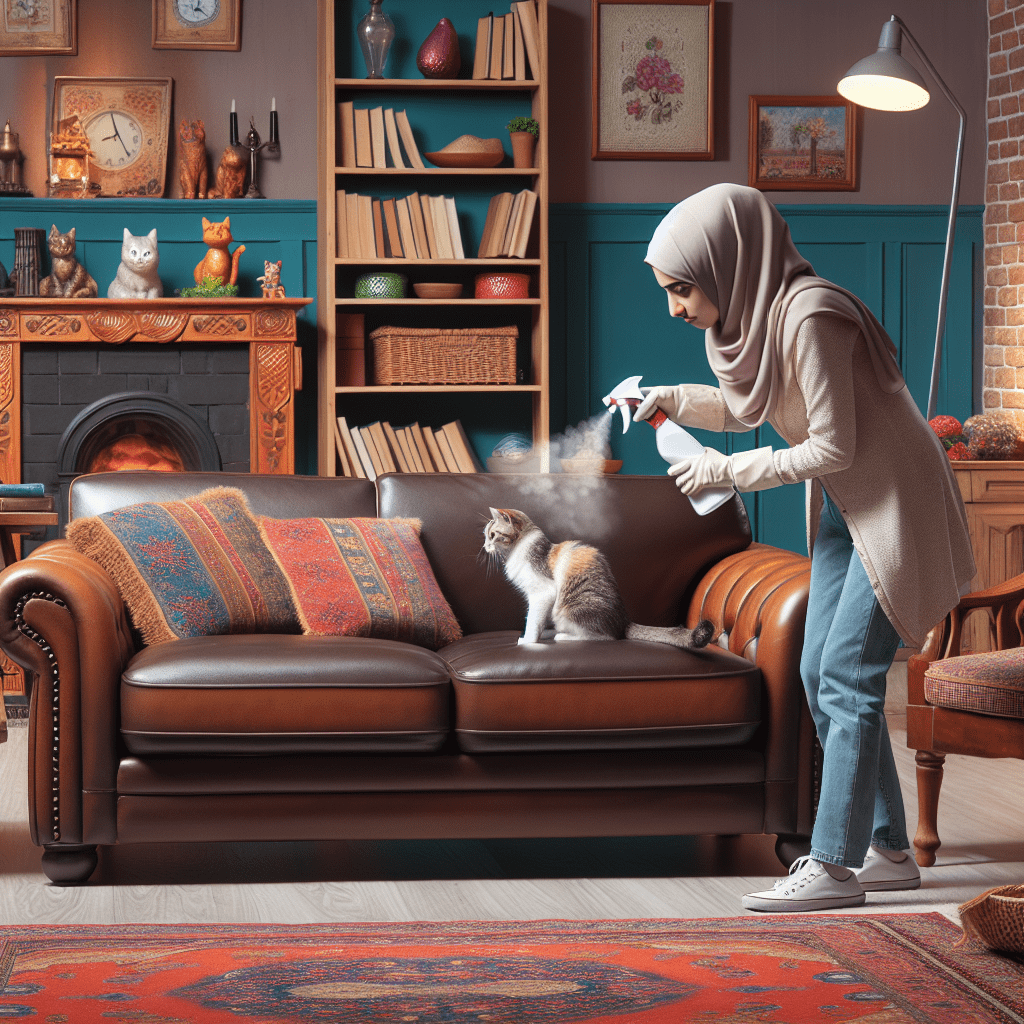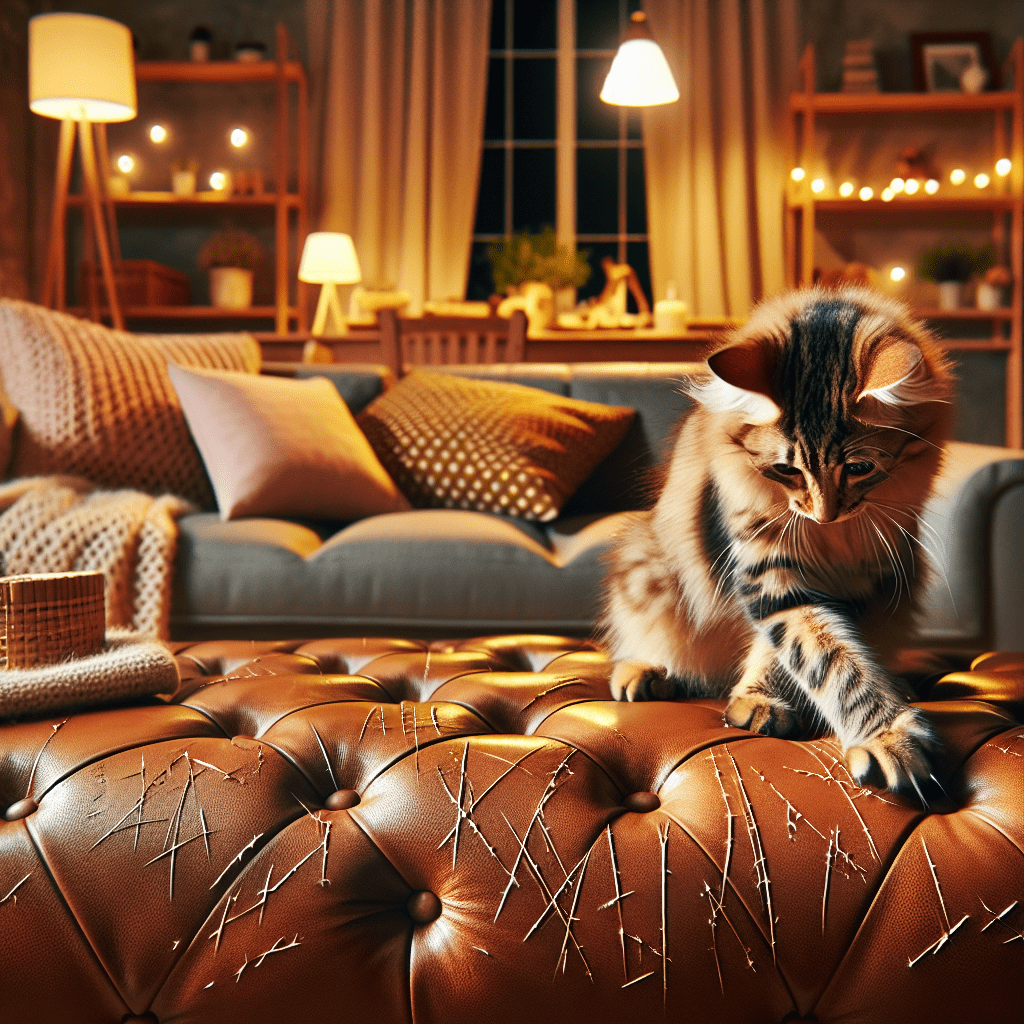Introduction
It’s a familiar scene for many cat owners—walking in to see your dear leather couch scratched up. Cats going to town on leather furniture is a big headache, risking damage to your expensive sofa and even putting your kitty in harm’s way. This blog post is here to help out. We’ll dive into why cats can’t resist scratching, give you some smart tricks to shield your furniture, and point you toward products to make your home more cat-friendly.
Table of Contents
Understanding the Behavior
Why Do Cats Scratch?
So, let’s get into why our furry feline pals love scratching so much! Cats do it instinctively, you know? It’s natural, and they have good reasons for it. First off, it’s their way of marking territory. When they scratch, they leave a mark and their special scent from glands in their paws. Plus, it helps keep their nails healthy by shedding the dead outer layer. And hey, what about the stretching they do while scratching? It’s like a mini workout that helps them relieve stress. Cool, right?
Differentiating Between Destructive and Normal Behavior
It’s essential to differentiate between destructive scratching and normal cat behavior. All cats scratch, but when this activity turns destructive, it usually means they’re not meeting their needs elsewhere. If your cat is clawing at your leather furniture, it’s likely because they don’t have an appropriate scratching post or pad. By understanding this, we can better address the root of the problem.

- Keep the Furniture Covered: One of the best ways to protect leather furniture from cat scratches is to keep it covered when not in use. You can use a sheet or slipcover to cover the furniture, especially when you are not at home. This will prevent your cat from being tempted to scratch on the leather.
- Provide Scratching Alternatives: Cats love to scratch as it helps them stretch their muscles and groom their claws. It’s important to provide your cat with alternative scratching options such as a scratching post or mat. This will redirect their scratching behavior away from your leather furniture.
- Use Citrus Scented Spray: Cats dislike the smell of citrus fruits, so you can use a citrus-scented spray on your furniture to deter them from scratching. Make sure to test the spray on a small inconspicuous area first before using it on your entire furniture.
- Train Your Cat: Training your cat not to scratch on your leather furniture is easier said than done but it is possible with consistency and patience. Whenever you catch your cat scratching the furniture, gently redirect their attention and reward them for using their scratching post instead.
Remember, prevention is always better than cure when it comes to protecting leather furniture from cats. By following these tips consistently, you can ensure that both your cat and furniture coexist peacefully in your home without any damage or scratches.
Deter Cats from Scratching
Use deterrents such as double-sided tape or specially formulated sprays that cats dislike the smell of on areas of your furniture that you want to protect.
Seek Veterinary Advice
If your cat’s scratching behavior is excessive or destructive, consult your veterinarian. They can provide guidance and recommend behavior modification techniques or medications if necessary.
Strategies to Protect Leather Furniture
Providing Appropriate Scratching Posts and Pads
The easiest way to deter your cat from your leather furniture is to give them an acceptable alternative. Invest in scratching posts and pads that cater to your cat’s preferences. Some cats enjoy vertical scratching, while others prefer horizontal surfaces. Observe your cat’s habits to choose the right type of scratching post. Place these posts near the furniture they usually scratch. This way, they will have a convenient alternative that allows them to mark their territory.
Using Deterrents and Training Techniques
Deterrents work wonders in protecting your leather furniture, you know? Things like citrus sprays or double-sided tape can help stop your cat from messing up the areas you want to keep looking good. These deterrents do the trick because cats usually aren’t into the smell or texture. Oh, and training methods can be super helpful, too! Give your cat a pat on the back when they use their scratching post – positive reinforcement, you got it! Treats, praise, or even their favorite toy can all help encourage good behavior.
Regular Nail Trimming and Environmental Enrichment
Trimming your cat’s nails regularly is a practical move. It helps prevent them from wrecking your furniture. So, make nail trimming a regular part of your cat’s grooming routine. Oh, and remember to spice up their environment! Offer toys and playtime to keep your furball entertained and less prone to scratching out of boredom or annoyance. A fun-filled setting makes your cat happier and less inclined to act out.
Product Recommendations
Cat-Friendly Furniture Protectors and Scratching Posts
When protecting your leather furniture, there are several products worth considering. Furniture protectors like those made from vinyl or plastic can shield your sofa from claws without ruining its aesthetic appeal. Brands like Clawguard and Sticky Paws offer reliable options. For scratching posts, brands like SmartCat and PetFusion are known for their durability and variety. Choose high-quality materials to attract your cat and stand the test of time.

Effective Deterrent Sprays and Tapes
Deterrent sprays and tapes are a great addition to your arsenal against cat scratching. Citrus Magic and Sss cat are popular sprays that cats find unpleasant. For tape options, Sticky Paws offers a double-sided tape specifically designed to deter cats from scratching. These products are easy to apply and highly effective, making them a convenient solution for busy homeowners.
Case Studies and Success Stories
Real-Life Examples
Real-Life Examples: Sarah’s Success Story Let’s hear from Sarah, a cat owner who successfully protected her leather couch. By introducing a scratching post near the furniture her cat used to scratch and applying a deterrent spray, she saw a significant improvement within two weeks. Her cat now exclusively uses the scratching post, proving that with the right strategy, you can protect your leather furniture effectively.
Testimonials of Improvement
Another success story is from John, who used double-sided tape and regular nail trimming to curb his cat’s destructive behavior. Within a month, his leather furniture showed no new scratch marks. His cat adapted well to the changes and now enjoys scratching a dedicated post. These real-life examples prove that with the right strategy, you can protect your leather furniture effectively.
Conclusion
To sum it up, it’s all about patience and the right approach when it comes to stopping your cats from scratching your leather furniture. Understanding why they do it and offering them good scratching options can help. Ratched posts, deterrent sprays, and furniture protectors can be lifesavers. Keep up with your training and ensure your cat is content and engaged.
All you pet parents out there, take your time with these methods. Your kitty will thank you with better behavior. Share your stories and tips below – you might help someone else out!
Check out our other posts for more tricks on making your home pet-friendly. Let’s keep our spaces beautiful and our feline pals purring!
—
Following these guidelines, you should be well on your way to a scratch-free, beautiful leather sofa and a happier cat. Happy training!
Frequently Asked Questions (FAQ)
How often should I trim my cat’s nails?
Regularly trimming your cat’s nails is important to prevent them from wrecking your furniture. Aim to trim those claws every 2-3 weeks. Remember to use the right clippers and be careful not to cut too far, as it can hurt and make them bleed.
Are there specific scratching posts that are better for leather furniture?
While any high-quality scratching post can be beneficial, look for sturdy posts made from materials like sisal or carpeting. Brands like SmartCat and PetFusion offer excellent options. Cats vary in preference, so finding the perfect post for your feline friend may take some experimentation.
What should I do if my cat continues to scratch the leather furniture despite trying these methods?
Persistence is crucial! Make sure you mix it up with different scratching posts and pads. Keep using deterrents and think about adding more fun stuff around. If things continue, chat with a vet or pet behavior expert for personalized tips.
Can I use more than one deterrent method at the same time?
Yes, combining multiple deterrent methods can amplify their effectiveness. For instance, you can use deterrent sprays, double-sided tapes, and consistent positive reinforcement training. The goal is to create an environment that provides clear alternatives to scratching your leather furniture.
Will using deterrent sprays harm my cat?
Usually, the deterrent sprays you get at stores are made to be pet-friendly. It’s a good idea to just double-check the label and follow what the manufacturer recommends. If your kitty looks upset or acts strange, just stop using it right away and have a chat with your vet.
How long does it take for behavior changes to become noticeable?
The timeframe could change based on your cat’s age, temperament, and past habits. Usually, you’ll begin to notice improvements after a few weeks of sticking to the strategies we suggest. Just remember, patience and sticking with it are super important!
Is it possible to completely stop my cat from scratching furniture?
While entirely eliminating scratching behavior may be challenging due to its natural instinct, you can significantly reduce unwanted scratching by providing suitable alternatives and employing effective deterrent methods. The goal is to redirect your cat’s scratching to more appropriate objects.
By addressing these common questions and maintaining a structured approach, you will take meaningful steps to protect your leather furniture and ensure your cat’s well-being.
Protecting Leather Furniture from Cat Claws
To protect leather furniture from cat claws, provide scratching alternatives like scratching posts or pads near the furniture. Use furniture covers, throws, or double-sided tape to deter scratching. Regularly trim your cat’s claws or use soft claw caps as an additional measure. Providing toys and playtime helps redirect their energy and reduces destructive behavior. Training with positive reinforcement can also teach your cat to avoid the furniture.
Sarah Smith is a passionate dog and cat enthusiast, blogger, and pet care expert. With years of experience researching and writing about various dog breeds cat breeds, she brings a wealth of knowledge and insight to her blog, PetPession.com. Sarah loves exploring the unique traits, histories, and care needs of different breeds, helping pet owners make informed decisions. Her mission is to create helpful, friendly, and well-researched content that both educates and celebrates the joy of pet ownership. When she’s not writing, Sarah enjoys outdoor adventures with her own furry friends.

